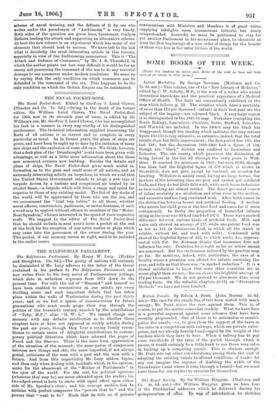SOME BOOKS OF THE WEEK.
[Under this heading we notice such Books of the week as have not been reserved for review its other fermi.] Infant Mortality. By George Newman. (Methuen and Co. 7s. 6d. net.)—This volume, one of the "New Library of Medicine," edited by C. W. Saloeby, M.D., is the work of a writer who unites theoretical knowledge and the practical experience of a Medical Officer of Health. The facts are conveniently exhibited in the map which follows p. 22. The counties which have a mortality of more than 170 per thousand—infants in their first year are the subject of the inquiry—are coloured black. A very large region is so distinguished in the 1845-54 map. Yorkshire (excepting the North Riding), Lancashire, Cheshire, Notts, Stafford, Leicester, and Warwick are included. In the 1900-5 map the black has disappeared, though the shading which indicates the very serious figure 150-170 is very extensive, so extensive, indeed, that the total results show but little improvement ; the first period has 145, the last 138 ; but the decennium 1891-1900 had a figure of 154, though the "black" district was confined to Lancashire and Leicester. The one county which preserves the distinction of being lowest in the list all through the sixty years is Wilt- shire. It reached its minimum in 1903 ; but even 85-63, though less than half the frightful figure of 179 which is shown in Shoreditch, does not give, except by contrast, an occasion for boasting. Wiltshire is mainly rural, having no largo towns ; the mothers of the labouring class are poor and cannot get artificial foods, and they do but little field work, while such home industries as lace-working are almost extinct. The direct pro-natal causes of infant mortality are alcoholism and other vices in the mother, and excessive and too long continued work. After birth comes in the distinction between breast and artificial feeding. A mother who nurses her child gives it the best food and cares for it more continuously. In Derby the proportion of breast-fed infants dying in the year was 69.8, of hand-fed 197.5. There was a marked difference between various kinds of artificial foods. Milk and water only showed an averaga of 177, while one patent food was as low as 134 (a farinaceous food, in which all the starch is soluble, without fat, and used with milk). Condensed milk showed the frightful figure of 255, to which rusks, &c., approxi- mated with 252. Dr. Newman thinks that insurance does not influence the rate. Doubtless he is right as far as active means are concerned. But the carelessness induced by the practice may go far. He mentions, indeed, with particulars, tho case of a locality where a premium was offered for infants surviving the year, and tells us that there was "a marked reduction." It is a dismal satisfaction to know that some other countries are in worse plight than we are,—Russia shows the frightful average of 272 per thousand. We do not pretend to give more than some leading facts. On the valuable chapters (9-11) on "Preventive Methods" we have not even touched.










































 Previous page
Previous page